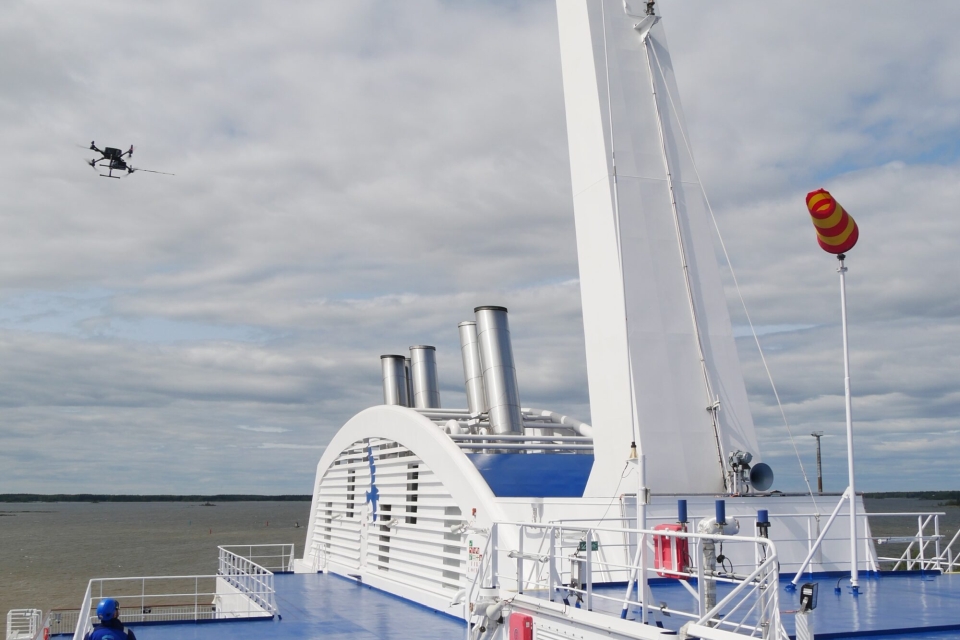The International Council on Clean Transportation (ICCT) has released a new report characterising methane emissions from ships fuelled by liquefied natural gas (LNG) operating in Europe and Australia. It is based on data collected by drones, helicopters, and onboard sensors during the two-year Fugitive and Unburned Methane Emissions from the Ships (FUMES) project.
FUMES is a collaboration between the ICCT, Explicit ApS, and the Netherlands Organization for Applied Scientific Research (TNO). The FUMES report, which was published today, 25 January, contains the most comprehensive dataset of real-world methane emissions from LNG-fuelled ships to date, including “methane slip” from engines and fugitive methane emissions from LNG cargo unloading operations.
Methane slip is the proportion of LNG fuel, which consists mainly of methane, that escapes unburned from the engine to the atmosphere. Real-world methane slip measured in the plumes of eighteen ships using the most common type of LNG marine engine (LPDF 4-stroke) averaged 6.4 per cent, whereas EU regulations currently assume 3.1 per cent methane slip, and the United Nations International Maritime Organization (IMO) assumes 3.5 per cent.
Also read: TNO develops electrolyser that requires 200 times less iridium
Increase the default methane slip value
The report therefore recommends that EU and IMO policymakers consider increasing the default methane slip value for LPDF 4-stroke engines to at least six per cent.
‘This study demonstrates the importance of collecting and analysing real-world data,’ says Dr. Bryan Comer, lead author, director of the marine programme, ICCT. ‘Regulators need to use the best available data to develop effective climate policies. If methane slip assumptions remain too low, shipowners will be able to use LNG in high-methane-slip engines longer, effectively getting an unfair advantage over lower-emitting fuels and engines.’
He adds: ‘This is contrary to the goals of rapidly decarbonising the shipping sector to align with the Paris Agreement and counterproductive to reducing global methane emissions this decade, as called for in the Global Methane Pledge.’
Also read: MAN solution aims for 70% reduction in methane slip
The value of remote measurement
‘This study shows that remote measurements are a valid and effective method to assess the real-world methane emissions from a broader fleet,’ states Jörg Beecken, senior research and project manager, Explicit ApS. ‘Both methane slip due to incomplete combustion and overall fugitive emissions can be reliably quantified using remote measurement techniques. The presented results provide a realistic and independent picture of maritime methane emissions.’
‘This study provides a concrete demonstration of the application of remote sensing techniques to determine representative methane slip levels and fugitive emissions from ships. While conventional measurement procedures such as for certification are designed to be accurate, they may not be representative,’ explains Robin Vermeulen, senior researcher, TNO. ‘Real-world measurements can overcome this discrepancy and can contribute to establishing representative data for fact-based policy-making.’
Also read: TNO: Hydrogen storage at sea seems feasible
Beware of low engine loads
Other findings from the study are:
- A modern LPDF 4-stroke engine can emit lower methane slip than assumed by the EU (3.1 per cent) and the IMO (3.5 per cent), but methane slip can still be substantial, especially at low engine loads, ranging from approximately four to seven per cent when engine loads are 25 per cent or lower.
- Unloading large LNG tankers can result in 24–40 kg/h of fugitive methane emissions, including approximately 8 kg/h of methane slip from the ships’ LPDF 4-stroke engines.
- Onboard measurements found that methane slip and work-specific NOx emissions were highest at the lowest engine loads.
Further recommendations
Other recommendations for policymakers are:
- EU policymakers should consider requiring LNG-fuelled ships to plug into shore power or otherwise eliminate their at-berth emissions.
- EU policymakers should consider requiring monitoring, reporting, and verification of methane emissions at LNG storage and refuelling points.
- IMO policymakers should consider adding a ten per cent engine load test point and adjusting how emissions at each point are weighted in engine certification procedures to more accurately reflect real-world operations.
Picture: Explicit ApS uses a drone to measure methane emissions in the exhaust plume of a ship while TNO measures in the exhaust stack from the engine room (by Explicit ApS).








